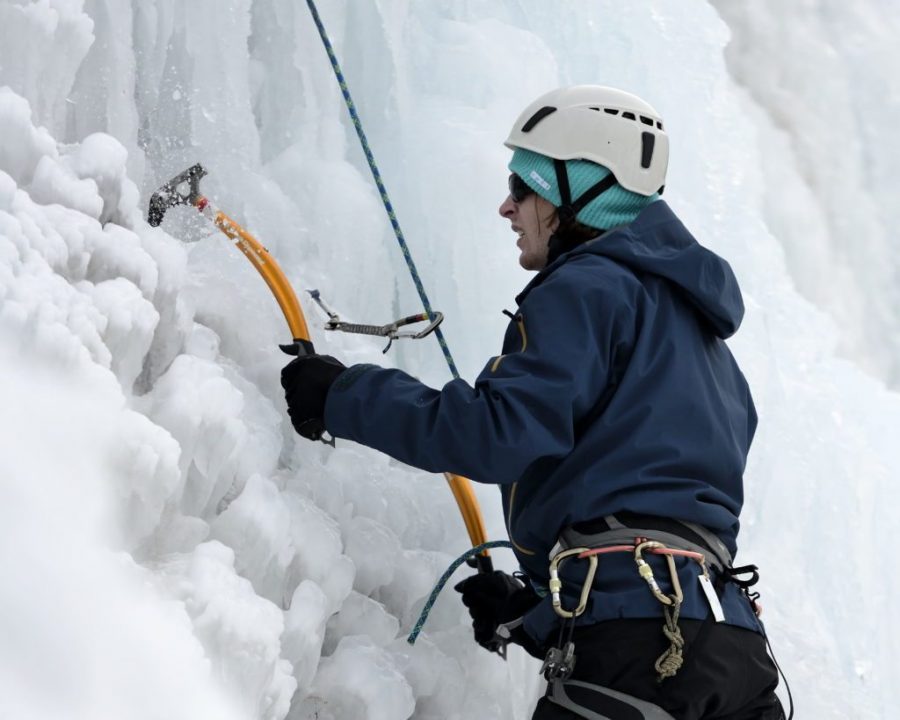Ice climbing, though a unique sport, parallels other winter activities I’ve tried in subtle ways.
It’s like skiing and snowboarding because you are wearing the same gear. It’s like rock climbing because you’re in a harness and attached to a rope. It’s like mountaineering because you use a pick and wear a helmet. What differs, though, is the suspense: You have crampons attached to your boots, your hands are connected to ice axes, and you are being supported by a wall of frozen water.
Ouray, Colo. is a world-renowned ice climbing park. People come from all over to learn to ice climb on this vertical. The ice park is located five minutes from the main street in Ouray in the Uncompahgre Gorge, which is about a mile long and has canyon walls ranging from 60 to 200 ft. in height. The ice that forms on the walls is maintained by a series of water pipes along the canyon rim with sprinklers that spray water at night to form a fresh layer of ice.
What makes the ice park such a popular destination is that it gives novice climbers the ability to learn ice climbing with the safety of top-roping. It is also a great place to figure out how to place ice screws and lead climb in a safe environment.
Over winter break, I traveled to Ouray, which is about six hours from Salt Lake City. The drive there was stunning — there was a fresh coat of snow covering the roadside scenery. Once in the town, you’ll see ice climbers walking around with their climbing gear on and packs hung over their shoulders. The temperature at night was in the single digits, which is great for the formation of new ice.
Pack your day bag, and head out early in the morning. It’s crucial to get a good route in the ice park that is near the bridge because of the close proximity to the lodge and fireplace. After you park and get your climbing gear out, fasten your crampons to the bottom of your boots to ensure traction. It is a requirement in the park to have crampons, to prevent falling down the Gorge, as well a helmet, to protect you from falling ice and debris.
The first thing you’ll do once you have your route selected is to set the anchors and flake the rope to make sure there are no knots. After that, attach your belay device to the rope and throw the remaining length over the cliff. Rappel down to the bottom of the gorge — there you will meet up with your group, who will help belay while you climb.
Once you are finally ready to start ice climbing, you’ll need to pick up your ice axes. They will act as extensions of your hands. Swing one arm at a time until the ax is set deep in the ice. You might have to take a couple of swings to get it set properly. You’ll then kick to get your crampon set in the ice.
Remember to mimic the shape of the letter “A” so your arms are directly above your head and your legs form a foundation for balance. Slowly inch your way up by finding new spots to set your ice ax to move yourself up the wall. At first you’ll want to use your arms, but relax and remember to use your legs.
During your ascent up the ice wall you’ll come across parts that will break away and fall to the bottom of the gorge. When you swing your ice ax and it doesn’t set, but instead causes a large hunk to fall, yell “Ice!” so your belayer doesn’t get hurt.
On reaching the top of the cliff, you’ll have accomplished your first ice climb. Your hands will sting as the blood rushes back into your fingers in the frigid air. Your heart will beat vigorously. You are now hooked. You’ll want to climb more. Don’t worry — that’s exactly how I felt.
After a long day of climbing in the gorge, be sure to stop by the local hot spring and relax with your friends. At night, it’s where everyone goes to recover.



